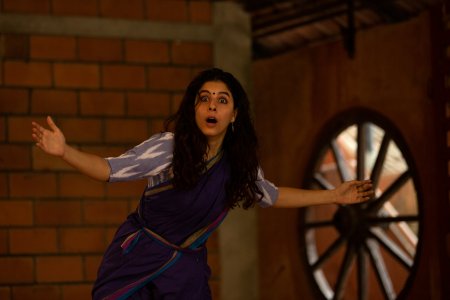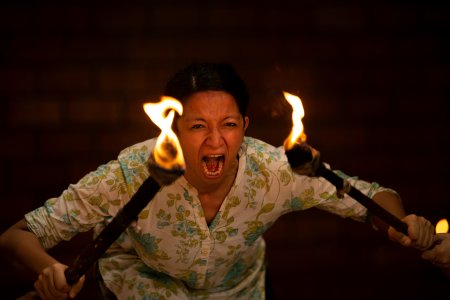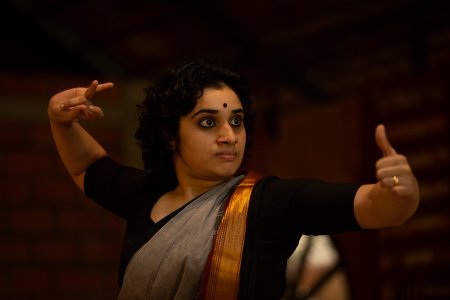
|   |

|   |
Navarasa Sadhana and Self-Transcendence - Meera Sreenarayanan e-mail: meeraguruvayur@gmail.com Photos: Manoj Parameswaran June 26, 2023 Summer heat was oppressive that morning, and there was no sign of even a slight breeze. However, one could hear the thunderous drum beats at Natanakairali, which prompted the dense cloud of emotions that had gathered throughout the course of time to start to descend. Navarasa Sadhana is no less than a retreat for an artist who wishes to strengthen their capacity to provide the audience a sense of Rasanubhuti. Nearly three generations of intellectuals from the Kodungallur Kovilakam have conducted novel investigations and research on the accomplishment of Navarasas, from Vidwan Elaya Thampuran to Bhagavathar Kunjunni Thampuran. Based on his decades-long scrutiny into these practices of the Kodungallur royal family, Kutiyattam and Natyasastra, G. Venu designed the Navarasa Sadhana, a methodically laid out framework for the everyday training of nine basic emotions for actors and dancers. During this practice of Navarasa Sadhana, it is fascinating to observe how the Natyasastra's theory of Rasa Sutra, Kodungallur Kalari's Swaravayu technique, and a few distinct Kutiyattam methods all flow in tandem in a very contemporary setting.  Isha Talwar  Niharika Negi We are performers attempting to improve every day at what we do, as William Shakespeare famously said, "All the world's a stage." After completing two of the eight phases of the Navarasa Sadhana, one might appreciate how crucial it is to pay attention to everything that happens in life. Building an emotional lexicon for the actor within an individual comes from a deep analysis of such responses to real events. In order to depict the character in his own acting style, the actor borrows these subtleties from the individual and applies them to the character being portrayed. This was a significant realisation since it showed how unaffected the individual is by the role, regardless of who or what he represents, and how unaffected one can be by any circumstances in life. This is further underlined by Venu-ji's consistently empathetic and nonjudgmental presence throughout this workshop. He acts as a silent witness, allowing us to be unfettered in exploring the inner depths of our beings and be a testimony to all the aspects of ourselves that we may find peculiar and sometimes weird. Niharika Negi, a participant and an interdisciplinary artist (theatre/filmmaker) agrees that "his presence enables us to embrace the whole of ourselves." The third phase of Navarasa Sadhana likewise lasted two weeks, at the receptive lush surroundings of the Natanakairali campus at Irinjalakuda, isolated from the hurly-burly of daily life. Every day, we started our practice with the eye movements that Bharata outlined in his Natyasastra. These were distinct from the Kerala acting tradition's eye and breathing exercises that were taught to us in the previous two phases. The relationship between eye and the emotion in focus was repeatedly highlighted during practice of each rasa across this phase. We learned how to make thinking visible and tangible through the quality of one's gaze by concentrating on a particular emotion. Following this, Mukharaga was executed as advised in Natyasastra, along with facial exercises. Contrary to common misconception, Mukharaga is not the painting of the face with colours; rather, Venu-ji uses five senses and appropriate breathing to conjure hues such as svabhavika (natural), prasanna (bright), rakta (reddened), and shyama (dark) on the flesh of the face.  Meera Sreenarayanan  Dhruti Shah After that, we continued on to thoroughly examine each rasa. We centred on the Vipralambha (when in separation from the lover) aspect of Sringara with both feminine and masculine genders active. The first goal was to elicit the sound of breath by singing a melancholic tune aloud. This was pursued by the persona of a female character and her tale of one's choosing. We were already equipped thanks to phase two of the training to understand and feel about gender in terms of its energies rather than just its outward setting. The portrayal of Arjuna's perception of Sri Krishna's Viswarupam (cosmic form) brought on the Adbhuta rasa. When a monarch was about to embark on a battle with his adversaries, Veera rasa was invoked. The actor's mind and physique received the requisite lift by using a fire torch while evoking Raudra rasa. For Bhayanaka rasa, it was the character of Kamsan who was dreading his impending demise. Along with a few additional techniques, Karuna and Bibhatsa followed a pattern similar to that of earlier phases. The assignment of Hasya rasa caught everyone in a bind since it required us to make others laugh, which was by no means a simple task. But ultimately, everyone got the rhythm of it and completed the task at hand with relative ease. According to the Sanskrit treatise 'Balarama Bharatham', the state of Shanti was evoked. Each and every rasa was demonstrated with careful regard to the thought and its emotion, the eye and its gaze, the breath and its sound. We were gently led on a solitary voyage through many spatial and temporal realms of imagination, each with their own nuanced narratives. "I have yet to encounter anyone else who can unravel this profound realm of artistic awakening as G. Venu," rightly observes another participant and a theatre practitioner, storyteller and multidisciplinary artist, Dhruti Shah.  G Venu  Sumeet Thakur The final stage of instruction entailed experiencing, rather than acting out, the Vyabhichari bhavas (transitory states) listed by Bharata. These improvisational sessions were an essential and distinctive aspect of the training because they offered each participant an occasion to employ their imagination to construct an environment and emotional state they needed to operate in to create an experience for themselves. We had the opportunity to work on Dainya (meekness), Srama (fatigue), Madham (intoxication), Sanka (doubt), Moha (bewilderment), Alasya (laziness), Smriti (remembrance) and Asuya (jealousy), and each of these transitory states encountered due to different reasons. As a result of the body's incredible capacity for memory, we only need to experience such a state of emotion once for it to be stored in our bodies. This allows us to act out a comparable scenario on stage with perfect realism. With no less effect than the preceding phases, the third phase of the Navarasa Sadhana was deliberately conducted at a slower pace. However, Venu-ji's generosity in sharing his timeless tales and recollections made the fifteen days fly by in no time. Everything that was experienced and shared in the span of two weeks with the gifted participants was priceless. The summer's blazing heat that appeared to have no end was finally put to rest on the final day of presentations when nature shed her tears of contentment alongside us.  Meera Sreenarayanan is a Bharatanatyam practitioner from Guruvayur, director of Tatdhii Arts and Learning Pvt. Ltd., a winner of several accolades, and a graded artist in Doordarshan. She has Master degrees in Bharatanatyam and Physics. |